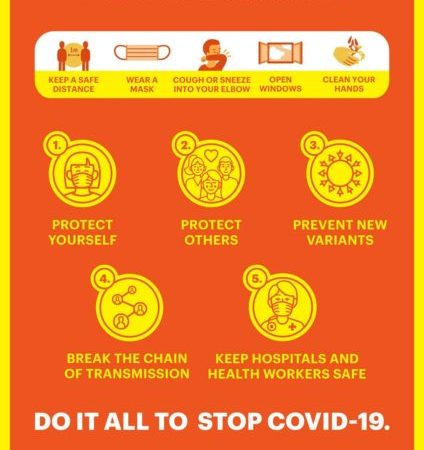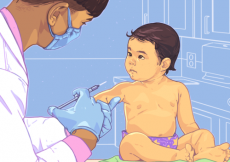November 17th, 2021
Even though children as young as 5 years old can now receive a COVID-19 vaccine protecting them against a potentially serious infection (potentially deadly for others), we are still not out of the woods regarding the pandemic. As winter grows dark and mean and everyone heads indoors to avoid the cold, Maggie Fox says the improving outlook in the U.S. now seems stuck, just in time for the holidays:
The coronavirus numbers don’t look so good this week. New Covid-19 diagnoses are up in about half of US states over the past week. Hospitalizations are up in 11 states, and deaths have risen in 17 states.
US coronavirus cases have plateaued in recent weeks, holding on to about half of the growth from this summer’s latest surge.
While new cases have fallen in some states, they’re rising in others, particularly some region’s cold-weather states.
Thanksgiving is a week away and some public health experts are getting nervous about a new nationwide spike in COVID-19:
Too many people remain unvaccinated, and too many continue to defy and even fight advice to wear masks when indoors with other people. This dangerous combination might mean more surges, even if not as high as in the recent past, and in areas beyond those currently seeing rising cases.
“I don’t know what’s going to happen over the next few weeks. But I have a feeling it’s not going to be pretty,” Michael Osterholm, who heads the center for Infectious Disease Research and Policy at the University of Minnesota, told CNN.
Pennsylvania’s COVID numbers are already going in the wrong direction, report Mike Stucka and J.D. Prose:
New coronavirus cases leaped in Pennsylvania in the week ending Sunday, rising 79% as 51,379 cases were reported.
Pennsylvania ranked fifth among the states where coronavirus was spreading the fastest on a per-person basis, a USA TODAY Network analysis of Johns Hopkins University data shows. The week prior, the state had 28,671 new cases of the virus that causes COVID-19.
The state’s surge well exceeded the national average as cases grew on average 11.5% across the U.S. from the week before
While we wait for children who are 5 and older to line up and get their recently approved COVID shots, we should continue to utilize all the tools in our toolbox to protect them, their younger brothers and sisters, and anyone else who is at risk for suffering a poor outcome from SARS-CoV-2. Let’s take a moment to review those layers of protection:
• Vaccines. Get vaccinated now!
◊ If you or your teenager have been holding out or reluctant to get immunized against this dangerous respiratory virus, now would be a great time to join the great majority of American society and get vaccinated.
◊ If you only received one dose of the Pfizer or Moderna vaccine, make sure to schedule your second dose. If you missed that second dose for some reason, go ahead and get the second one as soon as possible so you can be better protected and lower the risk of transmitting the virus to others.
◊ If you are eligible, get a booster (any brand is fine).
According to CDC guidelines, you are eligible to receive a booster dose if 6 months have elapsed since your second Pfizer or Moderna dose and you are:
• 65 years or older
• Age 18+ living in long-term care settings
• Age 18+ living with underlying medical conditions
• Age 18+ working or living in high-risk settings
If you are 18 or older and received the Johnson & Johnson single-dose vaccine more than 2 months ago, go ahead and get a booster dose of any brand now.
• Face masks. Everyone who is 2 years of age and older and not vaccinated should wear a well-fitted face mask over their nose and mouth in public indoor settings, according to the CDC’s latest guidelines. Even if you are fully vaccinated, wearing a face mask in public indoor settings is advised if you have a chronic medical condition or take medications that interfere with normal immune functioning, or if you are in an area of substantial or high transmission. (Good rule of thumb: If you are indoors with people whose vaccination status or medical history is unknown to you, please be considerate and wear a mask.)
• Avoid crowds and poorly ventilated spaces. Improving ventilation in indoor spaces and creating distance between yourself and others who you don’t know can both reduce the risk of viral transmission.
• Hand hygiene. We are now in cold and flu season, so every bit of hand washing helps reduce the spread of common viruses and bacteria.
• Stay home if you aren’t feeling well. Maybe you’re feeling under the weather with a common cold or a case of influenza. Maybe it’s COVID-19 (even a breakthrough case makes people feel crummy). Avoiding other people when you are suffering from a contagious bug is a good public health strategy to lower the risk of infecting others.
• Get a flu vaccine. Last year everything was locked down and most people stayed close to home. This year will be different as more of us venture out for work or play and the number of flu cases increases.
• Talk with your doctor. You chose your doctors carefully because you trust them. So pick up the phone and give them a call if you have questions and lean on them for the well-informed answers you deserve.
One final piece of advice for people who choose to remain unvaccinated: Please stay home for the holidays and keep yourselves and others safe from this very nasty virus.




































